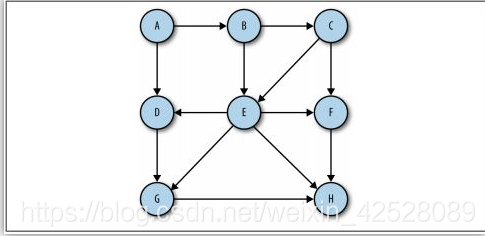BFS、DFS和dijkstra演算法 -python
阿新 • • 發佈:2018-11-16
bfs演算法,寬度優先搜尋演算法。

def bfs(graph,start): queue,visited = [start],[start] while queue: vertex=queue.pop() for i in graph[vertex]: if i not in visited: visited.append(i) queue.append(i) return visited G={"A":{"B","D"}, "B":{"C","E"}, "C":{"E","F"}, "D":{"G"}, "E":{"D","F","G","H"}, "F":{"H"}, "G":{"H"}, "H":{}} print(bfs(G,'A' ))
【'A', 'B', 'D', 'E', 'C', 'G', 'H', 'F'】
DFS演算法:深度優先搜尋演算法
def dfs(graph,vertex,queue=[]): queue.append(vertex) for i in graph[vertex]: if i not in queue: queue=dfs(graph,i,queue) return queue graph = { 1: [ 2, 3 ], 2: [ 4, 5 ], 3: [ 5 ], 4: [ 6 ], 5: [ 6 ], 6: [ 7 ], 7: [] } print(dfs(graph,1,))
執行結果[1, 2, 3, 4, 5, 6, 7]
dijkstra 演算法:求訪問完所有節點的最短路徑
G = {1: {2: 5, 4: 2, 5: 7}, 2: {3: 4}, 3: {}, 4: {2: 1, 3: 10}, 5: {3: 3}} def dijkstra(graph,source): visited =set() distance = dict((k ,float("inf")) for k in G.keys()) distance[source]=0 while len(G)!=len(visited): visited.add(source) for next_node in graph[source]: if distance[next_node]>distance[source]+graph[source][next_node]: distance[next_node]=distance[source]+graph[source][next_node] INF=float("inf") for node in distance.keys(): if node not in visited and distance[node]< INF: INF,source= distance[node],node return distance distance = dijkstra(G, 1) print(distance)
執行結果:
{1: 0, 2: 3, 3: 7, 4: 2, 5: 7}
